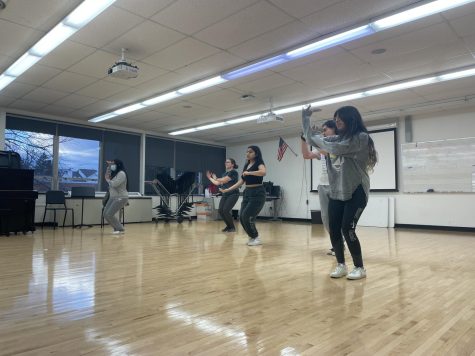Faculty, students address issues related to screen time effects

Capturing her remote learning work space on Dec. 9, sophomore Diana Nanos represents how many at MHS work or learn from home.
December 15, 2020
Are the effects of watching screens for long hours each day during remote learning an advantage or disadvantage to staff and students? The COVID-19 pandemic has raised this question as students continue to attend school remotely. Students, teachers and school nurses weighed in on the question and offered tips on how to manage screen time during this current working environment.
Returning students, like Diana Nanos, sophomore, are facing a year unlike any they have had at MHS. Nanos attended MHS in person her first year of high school, but now in her second year, there are new challenges she has had to overcome in a remote learning setting.
“I think learning in person makes such a big difference between learning on the screen,” said Nanos, who added, “When I learn in person, I’m able to communicate more.”
Nanos’ thoughts indicate how learning feels different for many students because screen time is colliding with past expectations of how students are used to learning.
“I think having a large amount of screen time for remote learning is having such a huge impact on many because as a school we aren’t used to learning online, virtually,” Nanos said.
Just as students are not used to learning online, many teachers aren’t used to teaching online.
“I think the hardest part [of remote learning] is how it is a requirement for us,” Math Teacher Patrick Hennelly said, noting the lack of choice in whether or not people want to be on a computer screen that much each day.
“People naturally don’t like change so that makes it even harder because they want to do what they normally did,” Hennelly said.
Therefore, switching what one is used to in a school environment has had a significant impact on students and teachers alike.
“Most students and teachers were in the routine of how school and teaching worked, but now, it is just different, and we have to relearn and reestablish routines we have been [doing] since we started school,” Hennelly said.
For a student who likes learning in person, online learning can have very different levels of engagement for some students.
“Staring at something sometimes gets me bored and wants me to move around,” Nanos said.
The need to move around not only can affect engagement, but it also has an impact on people’s health.
“My first thought about a reason for limiting screen time is the immobility that creates for our bodies,” Janette Swanston, school nurse, said.
The amount of time teens and adults should spend on screens every day is about two hours. Children 2-12 should spend around one hour a day, according to the Mayo Clinic Health System.
The online publication Science News for Students states our bodies are used to being in motion all day long, but while learning or working on Zoom, it is harder to fulfill our bodies’ needs.
“I have read through a chiropractor’s office that sitting is the new smoking,” Swanston said, who added, “[That] is how detrimental sitting and immobility is for our bodies.”
Research has shown that every 55 minutes, people need to do some sort of movement for about three minutes, Swanston said, referring to information she found on Mercola.com, a website run by Dr. Joseph Mercola, an osteopathic physician.
Swanston added both teachers and students should watch for any health differences they might be feeling in remote learning because of longer screen times when compared to in-person learning.
“Pain, headaches, soreness of back, neck, hips, sleepiness, sadness, depression, anxiety, fatigue, digestive issues, elimination problems,” can be signs of negative side effects, stated Swanston.
In addition to paying attention to changes in health, one could also consider tips on how to make their eLearning experience better.
Anabel Zires, system of support adviser, works at a desk daily and offers ways to overcome the difficulties of staying put at a screen for long periods of time.
“[So as] not to get distracted, make sure you stay on task; make sure you stay extremely organized,” Zires said.
She also offered another tip, saying, “Try to create a routine for yourself. Even if it’s different than your routine before, you can try to come up with a new one this year.”
Other ways students and staff are learning to cope with the remote learning environment Zires spoke of is by finding different places or ways to stay productive.
“I have a desk space set up in my room where I do most of my online work,” Hennelly said. “I think it has to do with routine.”
Such routines may include getting up at a certain time, having a designated work space and creating a space that allows one to focus. In that routine should be specific times a person gets up to move around.

![MHS Alum Trey Baker hosting a MBK rising event on February ninth at the MHS annex. Said Baker, “I’m just really excited [and] super grateful for the community of Mundelein, for our educators, for our administration, at MHS who are really buying into this.”](https://mhsmustang.com/wp-content/uploads/2023/03/TreyBaker-350x475.jpg)

